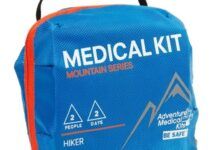In hot weather, a lot of people like to go barefoot aboard, but there are risks, from slipping to stubbing your toes. As much as we are sometimes tempted to toss the shoes below, we generally wear sandals. Indeed, we have long conducted a search for the perfect sandal. For years we favored our—get this—Hey, Sailor! canvas sandals. With a sturdy sole and lightweight canvas straps, they did the job, but the hook and loop tabs on the straps eventually lost their grip.
We often wondered when Teva, trendy king of outdoor footwear, would enter the marine market. Well, they did. Their Bluewater Series, specifically the Spinnaker model, is nothing short of terrific. Last summer we wore a pair of Spinnaker sandals and now pronounce them the best boating sandals we’ve ever strapped to our feet. The foot sits inside the sole’s curved edge or “fender” to prevent the foot from slipping out when you stop fast. The midsole is a cushy EVA with polyurethane heel “Shoc-Pad.” The multidirectional siping makes for good traction on deck.
We like the Spinnaker model over the other three in the Bluewater series only because it has two straps over the top of the foot and a third for the heel, thus making them the most secure. The straps, with plastic squeeze snaps, are adjustable, and there is good padding all around. While not cheap at $84.95, the Spinnakers are excellent. (Teva, PO Box 968, Flagstaff, AZ 86002; 800/367-8382; www.teva.com.)
A Few Books
Roger Marshall’s ninth book, Choosing a Cruising Sailboat, presents readers with a well-organized, easy to read mélange of important information ranging from the minutiae of algebraic calculations necessary to calculate boat performance to what he refers to as a boat’s “Comfort Factor.”
Much of the book’s appeal is its evaluation of design and sailing characteristics of four different types of boats: a Weekender designed for inshore sailing; a Cruiser aimed for a couple desiring a 34-36-footer; a Voyager and a Singlehander.
In addition to his ability to flush out and provide a criteria for evaluating critical components of a sailboat based on its intended use, Marshall stimulates readers at the outset with a comprehensive five-page questionnaire that will be of particular interest to potential buyers. (International Marine/McGraw Hill, 800/262-4729; 210 pages, $24.95)
First published in 1983, John Rousmaniere’s The Annapolis Book of Seamanship is now a well-established classic text on the sailor’s essential skills, from boat handling and sail trim to health, safety, rules of the road, navigation and etiquette. It is widely used by Power Squadrons and other groups for training and education. Now in its third edition, the book is handsomely illustrated with photographs and drawings. Chuck Hawley of West Marine paid it perhaps the ultimate compliment when he called it, “Better than Chapman’s.” That’s saying something. (Simon & Schuster, 403 pages, $40).
We’ve also long felt that more people should read Rousmaniere’s Desirable and Undesirable Characteristics of Offshore Yachts. (W.W. Norton, $32.95).
Michael Badham and former SAIL editor Robby Robinson (now an occasional PS contributor) teamed up for this fun project—Sailor’s Secrets— a collection of “pithy, often iconoclastic” advice from a wide range of sailing experts. Subject matter is essentially the universe. For example, master boatbuilder Eric Goetz says that to “enhance the eternal beauties of wood,” he likes to coat a cold-molded hull with clear epoxy, followed by clear Awlgrip, graphics and a final coat of clear Awlgrip.” Or Buddy Melges’ suggestion to chase your boat in a runabout to watch water flow off the stern as the crew makes various adjustments. “If the flow moved aft,” he says, “that meant the waterline lengthened and we were going faster. I call that plowshare engineering.” This isn’t the sort of book you’re likely to read cover to cover, but will keep in the bathroom for your daily meditations. (International Marine, 309 pages, $29.95)
You may have seen in several other magazines photos from An America’s Cup Treasury: The Lost Levick Photographs, 1893-1937. Edwin Levick, under whom Morris Rosenfeld apprenticed, chronicled the Cup for many years. On his death, hisphotos fell into the obscurity of a stock house. In 1955, the Mariner’s Museum of Newport News, Virginia, bought the collection. At last, with the help of Gary Jobson, the museum has published the lot. If black and whites of the grand J-Boats like Rainbow, Ranger and Endeavour, turn you on, this book won’t disappoint. (Mariner’s Museum, $45).




































